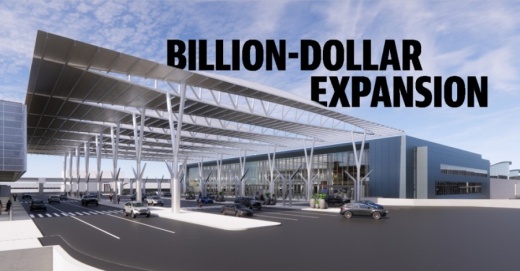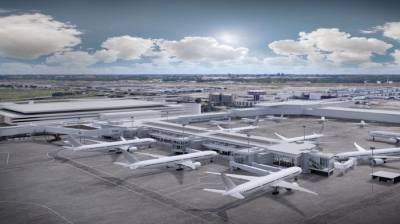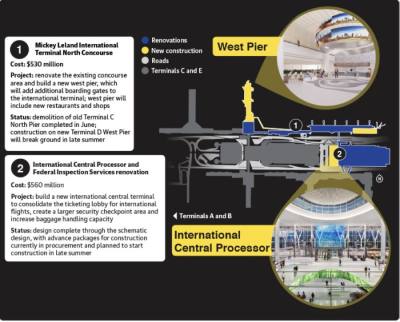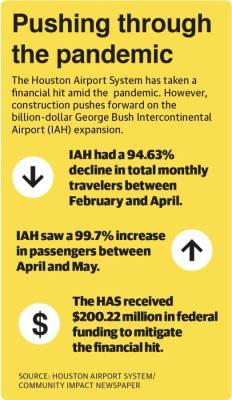The Houston Airport System continues its $1.3 billion capital improvement program, the IAH Terminal Redevelopment Program, despite travel decline from the ongoing coronavirus pandemic. Airport officials are pushing forward on one of the biggest parts of the program: essentially combining terminals D and E to expand the international footprint at the airport.
“This is the single largest capital development program that the city has invested in at Bush Intercontinental since the airport was constructed and opened in 1969,” HAS Chief Development Officer Robert Barker said.
Officials said the expansion will also contribute to the Humble area’s and overall Houston region’s economy and job growth.
Mark Mitchell, president of the Lake Houston Area Economic Development Partnership, said the partnership frequently leverages airport system improvements and other corporate-level expansions as incentives for new businesses to join the area.
“Those are all meaningful for both national and international companies,” he said. “The proximity of the airport along with the expansions is really important to economic development because we use it as a marketing tool to try and attract companies.”
International expansion
Barker said the expansion is targeted toward improving the airport’s capacity and customer experience for international services—the fastest-growing segment at IAH. More than 11.1 million passengers traveled internationally through IAH last year, according to HAS officials.
“The intent of our design is to design the international facilities such to that they are capable of efficiently handling 33 million enplaned international passengers [annually],” he said. “That prevents that facility from becoming obsolete for a very long period of time.”
Construction on the new Mickey Leland International Terminal will kick off in late summer with the $560 million central processor, which will be a hub located between Terminal D and Terminal E. The building will consolidate the ticketing lobby for international flights, create a larger security checkpoint area to expedite Transportation Security Administration lines and increase baggage handling capacity, Barker said.
Meanwhile, the $530 million new north concourse for planes and west pier will add additional boarding gates to the international terminal. The west pier will include new restaurants and shops, but HAS officials could not provide specifics on how many new tenants will join the airport.
The airport system expects the new international terminal—set to be complete by late 2024 or early 2025—will accommodate millions of passengers in the next 15 years, Barker said. However, the Humble-area airport has seen a decline in domestic and international passenger travel amid the pandemic.
HAS data shows IAH saw a 94.6% decline in total monthly travel between February and April from 3.37 million passengers to fewer than 181,000, but the airport saw a 99.7% passenger increase in May to more than 361,000.
Regardless of the pandemic, airport system officials still feel comfortable moving forward with the program—perhaps even at a faster rate, HAS Director of Aviation Mario Diaz said at the city of Houston’s June 17 Economic Development Committee meeting.
“There are market reductions in revenues we expect this year, not only this year ... [but] for next year,” he said.
However, Diaz pointed to $200.22 million from the federal Coronavirus Aid, Relief, and Economic Security Act funding as well as existing enterprise funds as reasons the HAS can push forward. The enterprise fund is independent from the city’s budget and not funded through taxes from local homeowners. It is funded by airline fees, bonds and concession fees, Barker said.
HAS Public Information Officer Augusto Bernal said he believes signs point to economic recovery before the terminal is complete.
”Projections indicate a recovery will be seen before the new terminal is complete in 2023,” Bernal said. “It’s critical we best utilize this time to prepare for the aviation comeback.”
Job growth
In addition to general regional economic growth, the two construction projects will bring many construction-related jobs to IAH through 2024, Bernal said.
“A construction this vast will bring jobs and opportunities,” he said.
Data from geographic information system company Esri shows 4,625 Lake Houston-area residents, or 6.68% of the local workforce, work in the construction industry as of the third quarter of 2019. Esri reported a 1.4% increase in construction-related jobs in the last five years, and the company predicted a 1.6% increase in jobs to become available in the next year.
The contractors of the two projects, Hensel Phelps and Austin Gilbane Joint Venture, will solicit personnel for the specific projects, Bernal said. Meanwhile, HAS solicits contracting jobs for numerous other airport projects at
fly2houston.com/biz, Bernal said.











